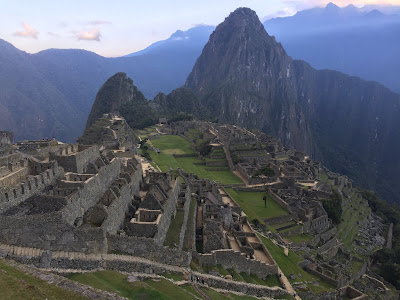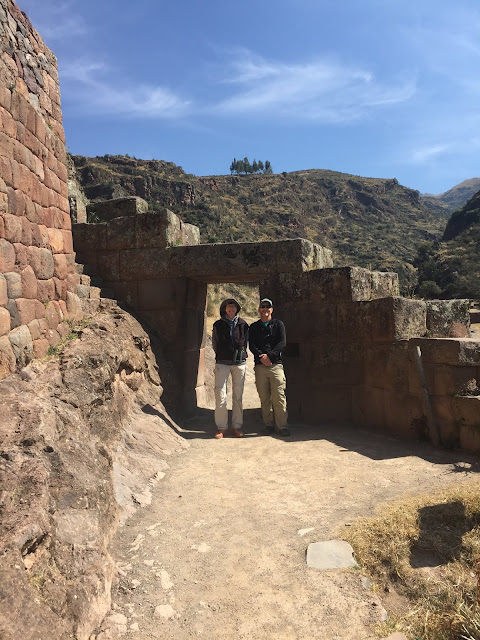 |
| Machu Picchu |
We started off with a quick tour of the Church of Andahuaylillas - the 'Sistine Chapel of the Andes.' Built in the 16th century, after Spanish colonization and conquest of the Inca empire. Unfortunately, photography of the inside was strictly prohibited, but we found the murals, gold-leaf altar, and coffer painted ceiling to be jaw-dropping amazing.
[All the sites we visited are hyperlinked to pages with more information, if desired]
Our first Inca site was Rumiqolqa, the southern gate to Cusco. Here we found outstanding Inca architecture, build on top of the pre-Inca Wari foundation, that included a major water canal elevated above the gate system.
Moving on, we visited Wari metropolis of Pikillaqta. This pre-Inca site was huge and dates back to 500 to 1100 AD.
Our final morning stop was Tipon, a master example of the Inca use of hydrology and agriculture.
Lunch at a local restaurant in Tipon town was entertaining. We partook in the local Chicharone, or fried pork. Our other choice was the local delicacy Cuy (or to most of us, guinea pig). All the locals say it's great, but neither Susan or I could bring ourselves to eat a dish that was smiling back at us. :-)
After lunch it was off to the Tambomachay ruins, a small site also known as 'The Bath of the Incas' or 'The Inca Princess Water Temple.'
Our final stop would also be our first stop the next morning, so we got to see it in both sunset and sunrise light. And what a site it was. Saqsaywaman (pronounced Sexy Woman, even by locals) is a UNESCO world heritage site. Originally started in pre-Inca times, the final Inca construction included hundreds of huge carved granite stones, weighing hundreds of tons each, fitted together without mortar. Amazing.
Day 2 started in Saqsaywaman for early light and no crowds, and then we were off over a pass and down into the Sacred Valley of the Incas, 12 miles north of Cusco. A stop on the descent to the town of Pisac gave us a fantastic view of the valley.
We visited the Pisaq Inca site, and wandered up and down the trails to visit the guard towers, housing, and farming terraces.
Our final destination was to the ruins of Ollantaytambo, the royal estate of Inca Emperor Pachacuti. Incredible.
And then we were off to the big finale, Machu Picchu. From the train station at Ollantaytambo, we rode for 90 minutes down the dramatic Urubamba River canyon to the town of Aqua Caliente at the base of Machu Picchu. Our guide Jose knew all the tricks for seeing Machu Picchu with the fewest crowds, so the wakeup alarm was set for 3:45 AM.
We were in line for the buses up the mountain at 4:30 and on one of the first few at 5:30. Getting up early before the masses, and day-trip arrivals from Cusco, meant a very pleasant morning at the ruins. Machu Picchu is by far the most famous Inca ruin, and there's a lot of 'Disneyland' element to it, but it is spectacular. Getting there so early also allowed us to watch a spectacular sunrise over the ruins.
Afternoon train and car rides got us back to Cusco to meet up with the rest of our group. Next up: three weeks crossing the Andes and traveling down to, and in, the Amazon basin. Mucho Aves! (Many Birds!)





















































I love seeing the early ruins you went to. Sunrise at Machu Picchu must have been awesome. I'm glad you went there.
ReplyDeleteInka Tours at Peru offers guided journeys through the heart of the Andes,
ReplyDeleteshowcasing ancient Inca trails, vibrant culture, and breathtaking landscapes.
Their tours provide an authentic experience of Peru’s rich history and natural wonders.